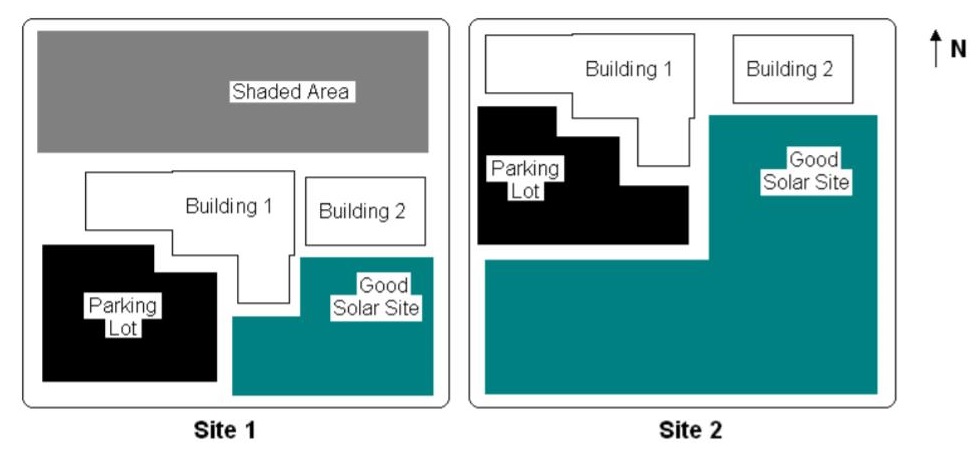Solar-Ready Building Design: A Summary of Technical Considerations
Sept. 22, 2017 by Alison Holm
We are seeing rapid transformation in the rooftop solar market with falling costs and increased deployment, but these changes don’t mean that every new building will suddenly be outfitted with a solar energy system tomorrow, or next week, or even next year. However, there are building design options that can be leveraged today in order to take advantage of potential solar installations in the future.
Solar-ready building design, as the name suggests, refers to designing and constructing a building in a way that facilitates and optimizes the installation of a rooftop solar photovoltaic (PV) system at some point after the building has been constructed. Solar-ready design can make future PV system installation more cost-effective by reducing the need for infrastructure upgrades, ensuring solar technical feasibility, and planning for PV system optimization. Solar-ready design is not a new concept—several states and municipalities, including California and Tucson, Arizona, have already started including solar-ready design mandates in their building ordinances and policies*—but it is still a relevant one, particularly in areas experiencing new urban development.
Two NREL reports, Solar Ready: An Overview of Implementation Practices and Solar Ready Buildings Planning Guide provide an overview of key technical considerations and a checklist of solar PV guidelines, summarized here. Important factors broadly include those related to building orientation and roof specifications, PV system and equipment requirements, and applicable regulatory policies.
Figure 1. Example of site layout impacts on solar potential
Building Orientation and Shading
Solar-ready design is rooted in determining the optimal placement of potential future
solar technology (see Figure 1). Building orientation impacts system functionality;
if a roof is sloped, siting the PV system on the south-facing segment will optimize
performance. Even small amounts of shading can reduce the output from solar PV systems,
so minimizing the amount of shading from surrounding vegetation and neighboring buildings
is critical, particularly on the south-facing side of the building.
Roof Design and Specifications
The type of roof material used can affect the cost of future solar installations.
To host a solar PV system, a roof must be able to support the weight of PV equipment—generally
between three and six pounds per square foot. At the time of building construction,
minimizing the amount of non-solar rooftop equipment will maximize the available area
for installing a solar PV system in the future. Also important is determining whether
the roof installation carries a warranty, and if the warranty includes contract terms
involving solar installations. Similarly, rooftop wind loads should be analyzed in
advance to ensure that the roof structure and solar equipment are rated to withstand
anticipated wind loads.
PV Equipment and Installation Considerations
Considering in advance where and how PV panels will be mounted can expedite the installation
process in the future. For example, if panels will be mounted with penetrating hardware,
building owners might consider installing the mounting hardware when the roof is installed.
Electrical conduits will also need to be routed from the solar PV system to the building’s
electrical panel. Identifying where the PV electrical equipment (including the inverter,
other balance of system components, and safety equipment) will be located and how
it will be configured can be integrated into the roof design process.
Initial PV System Design Considerations
Even if there are no immediate plans to install a PV system, understanding before
a building is constructed what, if any, special load considerations exist (e.g., if
the building will require uninterrupted power supply, whether electricity storage
will be necessary) allows those potential scenarios to be integrated into building
design. Additionally, assessing the potential PV system size and corresponding energy
production output can inform building design and result in optimized system sizing
at a later date.
NREL’s PV Watts and System Advisor Model (SAM) are online, interactive tools that building owners and developers can utilize to explore system sizing and output potential.
• PV Watts estimates energy production and costs associated with grid-connected solar PV systems:
http://pvwatts.nrel.gov/
• The SAM model estimates performance and cost of energy for grid-connected renewable energy systems
(not solar specific): https://sam.nrel.gov/.
Policy Factors
Policies impacting the use of distributed energy resources—including interconnection
standards and net metering policies—vary by location. Some states, for example, set
system size and aggregate capacity limits as part of their net metering policies,
which can influence project economics and decisions regarding PV system sizing. Similarly,
interconnection restrictions can impact how systems are configured.
Zoning Laws and Permitting Requirements
At the local level, zoning laws and permitting requirements may impact on-site solar
development and should be taken into account during the building planning phases.
Because shading can have a negative impact on PV system performance, understanding
the zoning context and whether future, neighboring construction might potentially
cast a shadow on the PV array is an important consideration. Applicable solar access
laws and historic preservation regulations should be evaluated as well.
For more detailed information on solar-ready design practices, check out NREL’s Solar Ready Buildings Planning Guide and subsequent report, Solar Ready: An Overview of Implementation Practices.
*In fact, some cities, like San Francisco are mandating actual solar installations on new construction, going well beyond solar-ready mandates. California is also considering a state-wide ordinance requiring solar installations on new buildings, modeled after San Francisco’s existing policy.
Share


